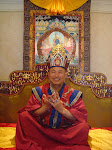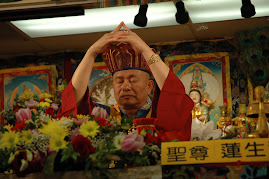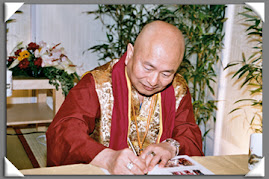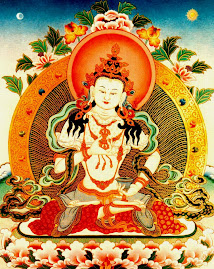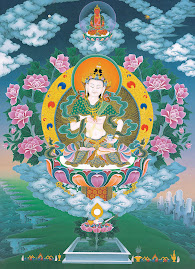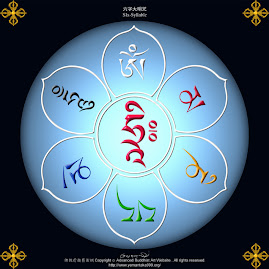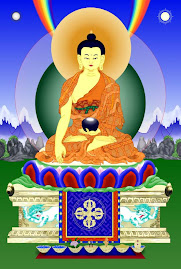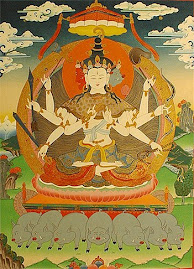
Hevajra
The first chapter of the awakening of Vajragarbha will help to explain:
Thus have I heard, Lord Buddha was residing in the womb of the Vajra Lady which is the Body, Speech and Mind of all the Buddhas
There Buddha spoke, "The heart of the Body, Speech, and Mind of all the Buddhas is the Noble Lord, who is the most secret of all the secrets. Oh Vajragarbha, great Bodhisattva of great mercy, listen to the essence of Vajrasattva, Mahasattva, and Samayasattva which is known as Hevajra."
Vajragarbha asked Lord Buddha, " Explain to me why He is called Vajrasattva, how is He Mahasattva, by what criteria is He Samayasattva?"
Buddha replied, "Vajra is said to be the indivisible and Sattva the unity of the three Centers. By this kind of wise reasoning Vajrasattva, the Adamantine Being, is so called. He is called Mahasattva because of
being full of the flavors of the Great Knowledge. And He is Samayasattva because of being uninterruptedly active at all times."
Vajragarbha asked, "What is intended by the composite name Hevajra? What is proclaimed by the sound HE and what by VAJRA?"
Buddha replied, "HE symbolizes Great Compassion and VAJRA symbolizes Wisdom. Now listen to this Tantra that I proclaim which is the essence of Wisdom and Skillfull Means.
The proficiency of this Tantra is known to be vast. This Tantra teaches the Gazes, how to attract, the Secret Sign Language, how to paralyze, how to drive away. It teaches the correct method of generating the Yoginis, their location, and their source. It is proficient in the science and technique of the correct method of manifesting the deities.
The first of these techniques is one method, the method of generating the Heruka, for it is by utilizing the existent itself that men are liberated. Oh Vajragarbha of great mercy. Men are bound by the bondage of existence and are liberated by understanding the nature of existence. Oh wise one, existence should be conceived through the understanding of
non-existence and likewise the divine Heruka should also be conceived through the understanding on non-existence.
Great Knowledge is located in the body and is free of all illusory conceptions, pervades all phenomenal things and although abiding in the body does not originate from the body."
Vajragharba asked, " Oh Buddha, how many nerve-channels are there in the Vajra body?"
Buddha replied, " There are thirty-two nerve-channels. These thirty-two are the bearers of the bodhicitta and flow into the center of Great Bliss. Among them three nerve-channels, Lalana, Rasana, and Avadhuti are the most important. Lalana has the nature of Wisdom and Rasana of Skillfull means. In the middle, between them is Avadhuti, free from the duality of subject and object. Lalana is the bearer of Aksobhya and Rasana is the bearer of Rakta. The bearer of both Wisdom and Moon is known as Avadhuti.
The names of the thirty-two nerve-channels are Abhedya, Suksamarupa, Divya, Vama, Vamini, Kurmaja, Bhavaki. Seka, Dosa, Vista, Matari, Savari, Sitada, Usma, Lalana, Avadhuti, Rasana, Pravana, Krisnavarna, Surupini, Samanya, Hetudayika, Viyoga, Premani, Siddha, Pavaki, Sumana, Traivratta, Kamini, Geha, Candika, and Maradarika."
Vajragharba asked, "Lord Buddha, what is the nature of these thirty-two nerve-channels?"
Buddha relied, "The nerve-channels are all transformations of the three realms of existence and are devoid of the duality of subject and object. But when they are used as means, they are all conceived as possessing characteristics of phenomenal things. The various Concealed Essences are mentioned: Ali and Kali, Moon and Sun, Wisdom and Skillfull means,
the centers of Essencial Nature, Enjoyment, Creation and Great Bliss, and the Body, Speech, and Mind. Evam Maya: by E the goddess Locana is indicated, by VAM Mamaki, by MA Pandura and by YA Tarini. In the Center of Creation a sixty-four petal lotus. In the Center of Essential Nature an eight petal lotus, In the Center of Enjoyment a sixteen petal lotus. In the Center of Great Bliss a thirty-two petal lotus.
The fourfold division that follows should be actualized in the proper order of the four centers described above.
The four Moments: Diverse, Ripening, Dissolving, and Signless.
The four Noble Truths: Sorrow, its Origin, its Cessation, and the WAY.
The four Principles: Self, Mantra, Divinity, and Knowledge.
The four Joys: Ordinary, Refined, Cessation, and Innate Joy.
The four Doctrinal Schools: Sthavari, Sarastivada, Samvidt, and Mahasanghi.
Moon, Sun, Ali and Kali, the sixteen Phases, the sixty-four Periods,
the thirty-two Nerve-channels, and the four Watches. Thus, everything
goes in fours.
Chandali blazes up in the navel. She burns the Five Buddhas. She burns Locana and the others. Aham is burnt and the Moon flows down."
Thus the first chapter regarding the Family of Vajra which is the Body, Speech, and Mind of all the Buddhas.
=============================
Here are the details of the Hevajra:
Shri Hevajra (Tibetan: pal gye pa'i dor je. English: Glorious Joyful Vajra): principle meditational deity of the Sakya School and central focus of the Lamdre cycle of teachings, together with eight goddesses, deities and lineage teachers above and protectors below.
SHRI HEVAJRA (Tibetan: pal gye pa'i dor je): principle tutelary deity of the Sakya School and central focus of the Lamdre cycle of teachings. Wrathful in appearance, dark blue in colour with multiple heads and hands he stands in a dancing posture amidst orange flames of wisdom fire.
At each side of the central blue face are three further faces with a small fierce face placed above making a total of eight. Each face has three eyes, yellow hair flowing upward, a crown of five skulls and earrings. With sixteen hands each holds a skullcup and a unique object inside. The first pair folded at the heart embrace the consort Vajra Nairatmya, light blue in colour with one face and two hands, holding aloft a curved knife with the right hand, standing embracing the consort with the right leg. Both are adorned with various wrathful ornaments, bones, skull garlands and the like. Atop a series of stacked figures, sun disc and multi-coloured lotus seat they stand completely engulfed in the orange flames of pristine awareness. In a half circle standing in front are the eight goddesses of the Hevajra mandala each with one face and two hands of various colours, holding unique symbolic objects and standing in dancing postures.
At the top center is the primordial buddha Vajradhara, blue, with one face and two hands holding to the heart the stems of two lotus blossoms supporting a vajra and bell. At the left is a mahasiddha, dark in colour, wearing a red meditation belt. At the right is a peaceful figure attired in the garb of a bodhisattva. At the far left is Sachen Kunga Nyingpo (1092-1158), dressed as a layman, holding a white lotus blossom in the right hand. At the far right a lama wears monastic robes and a red pandita hat. Below that are three lamas in a row all wearing monastic robes and performing various mudras. The central figure is seated on a large multi-petalled pink lotus.
At the middle left is Vajrayogini, red, with one face and two hands, in a standing posture. At the right is Bhutadamara Vajrapani, dark blue, wrathful, with one face and two hands.
At the bottom center is the wrathful protector Panjarnata Mahakala, black, with one face and two hands. At the right is the wrathful consort Shri Devi, black, with one face and four hands riding a brown mule. At the left is Brahmarupa Mahakala, in the appearance of an Indian mahasiddha. These are the three main Dharma protectors of the Sakya School.
Hevajra Lineage: Vajradhara, Nairatmya, Virupa, Kanhapa, Damarupa, Avadhutipa, Gayadhara, Drogmi Lotsawa, Seton Kunrig, Shangton Chobar, Sachen Kunga Nyingpo, etc.









